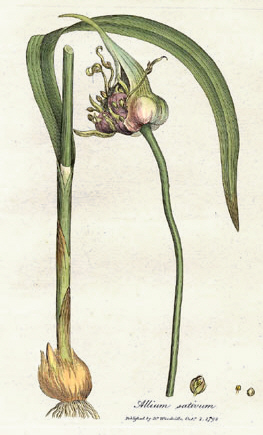
Chives, scientific name Allium schoenoprasum, is a species of flowering plant in the family Amaryllidaceae that produces edible leaves and flowers.

Allium ursinum, known as wild garlic, ramsons, cowleekes, cows's leek, cowleek, buckrams, broad-leaved garlic, wood garlic, bear leek, Eurasian wild garlic or bear's garlic, is a bulbous perennial flowering plant in the amaryllis family Amaryllidaceae. It is native to Europe and Asia, where it grows in moist woodland. It is a wild relative of onion and garlic, all belonging to the same genus, Allium. There are two recognized subspecies: A. ursinum subsp. ursinum and A. ursinum subsp. ucrainicum.

Abies nordmanniana, the Nordmann fir or Caucasian fir, is a fir indigenous to the mountains south and east of the Black Sea, in Turkey, Georgia and the Russian Caucasus. It occurs at altitudes of 900–2,200 m on mountains with precipitation of over 1,000 mm.

Allium sphaerocephalon is a plant species in the Amaryllis family known as round-headed leek, round-headed garlic, ball-head onion, and other variations on these names. Drumstick allium is another common name applied to this species. Some publications use the alternate spelling Allium sphaerocephalum. It is a bulbous herbaceous perennial plant.

Allium nigrum, common name black garlic, broad-leaved leek, or broadleaf garlic, is a Middle Eastern species of wild onion. It lacks the onion or garlic scent shared by most of the other species in the group. The species is native to Turkey, Cyprus, Syria, Lebanon, and Israel but cultivated as an ornamental in many other places. It has become naturalized in some regions, including parts of the United States.

Allium roseum, commonly called rosy garlic, is an edible, Old World species of wild garlic. It is native to the Mediterranean region and nearby areas, with a natural range extending from Portugal and Morocco to Turkey and the Palestine region. It is cultivated widely, and has become naturalised in scattered locations in other regions outside its natural range.

Allium siculum, known as honey garlic, Sicilian honey lily, Sicilian honey garlic, or Mediterranean bells, is a European and Turkish species of plant in the genus Allium. It is native to the regions around the Mediterranean and Black Seas, and grown in other regions as an ornamental and as a culinary herb.

Allium victorialis, commonly known as victory onion, Alpine leek, and Alpine broad-leaf allium is a broad-leaved Eurasian species of wild onion. It is a perennial of the Amaryllis family that occurs widely in mountainous regions of Europe and parts of Asia.

Allium hollandicum, the Persian onion or Dutch garlic, is a species of flowering plant native to Iran and Kyrgyzstan but widely cultivated as an ornamental because of its umbels of attractive purple flowers. It is reportedly naturalized in Saint Louis County, Minnesota.

Allium cyrilli is a plant species native to Greece, Turkey, and to the Apulia region of southeastern Italy.

Allium atropurpureum is a plant species native to Hungary, the Balkans, and Turkey. It is widely grown as an ornamental for its rich, deep purple flowers.

Allium flavum, the small yellow onion or yellow-flowered garlic, is a species of flowering plant in the genus Allium. A bulbous herbaceous perennial, it is native to the lands surrounding the Mediterranean, Black, and Caspian Seas, from areas like France and Morocco to Iran and Kazakhstan.
Allium tripedale is a species of wild onion native to the Caucasus, Iraq, Turkey, and northern Iran. It is related to Allium siculum. It produces up to 30 pink-violet bell-shaped flowers per umbel.
Allium basalticum is a plant species found in Israel, Jordan, and Lebanon, and formerly considered under Allium nigrum. Bulbs are egg-shaped, up to 30 mm long. Scape is straight, round in cross-section, up to 60 cm tall. Leaves are narrowly lanceolate, up to 50 cm long. Tepals are white with conspicuous green midveins; anthers yellow; ovary deep purple at flowering time, later turning green.
Allium israeliticum is a species of onion native to Israel, Palestine and Jordan. Bulbs are egg-shaped, up to 30 mm long. Scape is flexuous, up to 40 cm long. Leaves are thick, recurved, up to 30 cm long, tapering toward the tip. Tepals are translucent white with green midveins; anthers yellow; ovary green.
Allium dumetorum is a Middle Eastern species of onion found in Israel, Palestine, Lebanon and Jordan. It is a bulb-forming perennial with a few pinkish flowers; ovary pale green.

Allium curtum is species of flowering plant in the amaryllis family, Amaryllidaceae. It is native to Cyprus, Egypt, Lebanon, Palestine, the Sinai Peninsula, Syria and Turkey. It is a bulb-forming perennial producing a tight, head-like umbel of green or purple flowers.

Allium subhirsutum, the hairy garlic, is a plant species widespread around the Mediterranean region from Spain and the Canary Islands to Turkey and Palestine.

Allium akaka is a species of onion native to Iran.

Allium is a large genus of monocotyledonous flowering plants with around 1000 accepted species, making Allium the largest genus in the family Amaryllidaceae and amongst the largest plant genera in the world. Many of the species are edible, and some have a long history of cultivation and human consumption as a vegetable including the onion, garlic, scallions, shallots, leeks, and chives, with onions being the second most grown vegetable globally after tomatoes as of 2023.
















